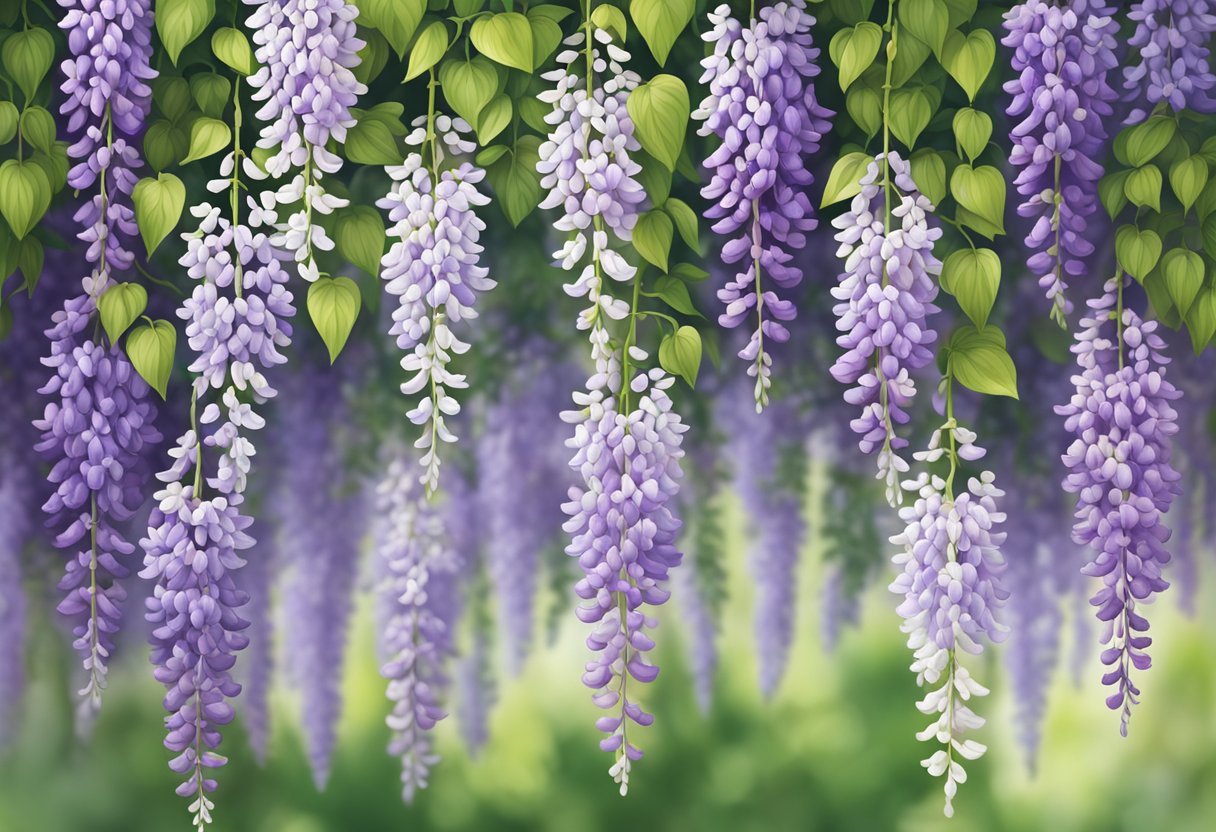Wisteria, with its graceful cascades of florals, is a captivating sight in many landscapes. My experience with this plant has shown that its flowering period is a highly anticipated event. The blooming season, offering a display of vivid colors and enchanting fragrances, is a magnificent reward for any gardener’s patience. Wisteria vines, once established, become a breathtaking feature, with their blooms creating spectacular springtime shows.

The duration of wisteria blooms often feels fleeting, yet they leave an indelible mark on the spring canvas. Usually, blooms last between two to three weeks but can extend up to a month when conditions are favorable. This vine’s remarkable display of flowers arrives typically in the springtime, around April and May, varying slightly based on climate and region. It’s a testament to nature’s cycles that every year, for those few weeks, wisteria transforms gardens into a purple-hued paradise.
As a robust and often vigorous grower, wisteria requires patience and care to reach its full blooming potential. Once established, the vine prioritizes the production of its striking racemes of flowers over new growth. This dedicated allocation of energy results in not only an impressive aesthetic display but also the beguiling aroma characteristic of wisteria flowers. Such characteristics make this vine an ornamental treasure in gardens across hardiness zones 5 through 9, where its flowering prowess can be enjoyed annually.
JUMP TO TOPIC
Planting and Growing Wisteria
Wisteria vines are an enchanting addition to any garden, but they require careful planting and specific growing conditions to thrive and produce their stunning blooms.
Choosing the Right Soil
Optimal Sunlight and Water Requirements
💥 It’s crucial for wisteria to receive full sun to ensure prolific flowering.
Japanese and Chinese wisteria varieties particularly demand a sun-drenched environment, ideally receiving at least 6 hours of direct sunlight each day. I am consistent with watering during the vine’s formative years, maintaining a balance to keep the soil moist but not waterlogged.
Support Structures for Wisteria Vines
Wisteria vines are powerful growers that require sturdy support structures such as pergolas or trellises for proper training and control.
Do not underestimate the importance of a solid structure; wisteria vines can become very heavy as they mature.
I prefer using materials like wood or metal that can withstand the weight and growth of the vines over many years. Proper installation of these supports is essential in the early stages of planting to accommodate the vine’s rapid growth and eventual size.
Caring for Wisteria Throughout the Seasons
Providing wisteria with the right care during the year is essential for a healthy plant and vibrant blooms. Specific tasks in pruning, fertilizing, and pest control contribute to its thriving.
Pruning and Maintenance
I prune my wisteria twice a year to maintain shape and encourage blooming. In late winter, I cut back at least half of the previous year’s growth, leaving several buds on each stem. In summer, after the blooms have faded, I cut back the new shoots to about a foot long to tidy the vine.
- In late winter, cut back last year’s growth by half.
- During summer: Trim new shoots to 12 inches long.
Fertilization for Optimal Growth
In early spring, I apply a nutrient-rich compost near the base of the vine. I also ensure to cover it with a layer of mulch to help retain moisture. Using a phosphate-rich fertilizer supports the root development and enhances flowering. However, too much nitrogen can lead to excess foliage at the expense of blooms.
Dealing with Pests and Invasive Species
Wisteria can be both a delight and a challenge. Vigilant care is needed to prevent it from becoming invasive. Regular inspection for pests like aphids is key. If I find any, a gentle horticultural soap solution is often enough to handle them. I also keep an eye on its spread, cutting back any shoots trying to take over nearby plants to maintain control in my garden.
💥 Remember: Regular care prevents wisteria from becoming invasive and keeps it healthy for the blooming period.
Appreciating the Beauty of Wisteria Blooms
The enchanting wisteria vines drape gardens in hues of purple, blue, pink, and white, transforming them each blooming season. With a blooming period that marks the coming of late spring, these fragrant flowers offer a splendid display that’s eagerly anticipated by gardening enthusiasts like me.
The Splendor of Blooming Seasons
Wisteria, a robust and often fast-growing vine, is known for its spectacular blooms in the late spring. Its flowers hang in graceful racemes that can reach up to a foot in length. Depending on the species and local climate conditions, the wisteria bloom season can grace the garden for two to three weeks.
Wisteria can bloom for two to three weeks, depending on environmental factors.
These vines require ample sunlight to flower prolifically. They’re hardy in zones 5 through 9, and once mature, their blooms appear annually. However, the vines may need several years to establish, particularly when grown from seed, which can extend flowering time significantly.
Varieties and Their Unique Characteristics
Wisteria differs notably between varieties, not just in color but also in the time taken to reach maturity and the length of bloom. The most popular wisteria species include:
- Chinese wisteria (Wisteria sinensis), characterized by its bluish-purple flowers.
- Japanese wisteria (Wisteria floribunda), which boasts impressive flower cluster lengths and an array of color variants including violet, blue, and white.
- American wisteria (Wisteria frutescens) and Kentucky wisteria (Wisteria macrostachya), which are known for their hardiness and slightly more restrained growth habits compared to Asian species.
Each variant of wisteria adds its unique touch to the garden landscape, with blooming periods influenced by their genetic makeup and care practices. As a gardener, I have noticed that pruning and proper care can enhance the flowering of wisteria, helping these magnificent vines to produce an even denser and more stunning floral display.












